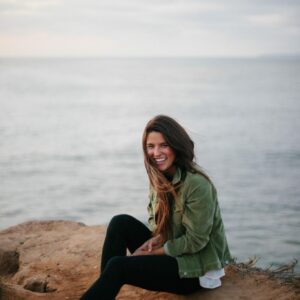Through my camera lens, I saw a woman who was probably used to being overlooked. Her mischievous smile gave her a sense of innocence, but her cheeks, gaunt from missing teeth, betrayed her. She had been through something and my guess as to what it could be was as good as any. But hers was the most beautiful picture I took that night. I didn’t have to use the flash—the camera trained on her face, marked as it was by struggle and loss, lit her with joy.
An hour earlier, I hurried across a dimly lit parking lot behind a long-term rehabilitation center and nursing home in a suburb just north of Chicago. I was there to observe and photograph while volunteers from a local church served an early Thanksgiving dinner and held a worship service for residents, who stayed there for months or even years, recovering from surgeries, injuries, or addiction, or if a mental illness meant they could no longer take care of themselves. But even knowing this, I didn’t think the story I was supposed to write would be anything special. In fact, compared to other volunteer opportunities I’d written about, where families took in children to keep them out of the state’s foster system, it seemed barely consequential. What system were we changing? Who is going to care?
I watched as volunteers filed in. They came from a large suburban church in Chicago, the same one I had attended since I was a baby, though at a different campus. This particular satellite was about to start construction on a brand new building–a modern cathedral–designed by a world-renowned architect who happened to be a regular attender.
I adored this church. I thought it was what a church should be, and, in many ways, it was: these people filing into a rehabilitation center on a cold Wednesday night were case in point. But along the way, my idea of what the church was—or perhaps, who it was—became skewed.
I once thought a church was a building, bound by clean lines and large, stained glass windows, transparent but altogether separate from the outside world. As I got older, I thought the church was defined by a particular group, bound by school districts, shared beliefs, and major highways. It was a collection of people, but again, clear boundaries remained. Churches, I gathered, were specific, limited, and predictable, and that was the rule.
On that night Elena, the ministry’s leader, greeted each volunteer warmly in the center’s lobby even as paramedics rolled a stretcher through to transport a resident to the hospital. Some volunteers she knew well from months and years of serving together each week, while others came for the first time, uncertain of where to go. She pointed middle-aged couples and young families and hesitant teenagers to the multipurpose room, where others were already lining tables with silver serving dishes, brimming with turkey and green beans and cranberry sauce donated by a family from the church.
The room began to fill as residents ambled in, some on their feet and others in wheelchairs. I watched with surprise: there was no consistency in the people now seated at round tables, chatting with each other and with volunteers who had become cherished friends. There were frail women using walkers and vibrant young men who bounced from table to table. Some could no longer take care of themselves because of Alzheimer’s while others were limited by physical ailments. I spoke with one woman who would leave soon, once she had recovered fully from her hip surgery. Later I met D’Angelo, the self-appointed ministry liaison who attended the church on Sundays and knew absolutely everyone. He came to the center more than a decade ago to escape a life marred by drugs and alcohol and never left; he believed God had called him there so that he could minister to others who were trying to leave addictions behind.
As I orbited the room, snapping pictures, I thought I understood the story: a group of people, diverse in every way, whose sufferings ran the gamut of illnesses, blessed by their well-to-do neighbors on a cold November night.
But then I paused for a few moments. I joined a table while Andrew, a father of three and a leader at the church, led a devotional. I wish I remembered what he said, but I don’t. As I looked around the room, buzzing and filled with the warmth that follows a good meal and good conversation, I saw volunteers and residents sitting side by side, hearing the same devotional and singing the same songs. And I realized that what I was seeing that night was the church, in all its strange beauty.
The church was that group of mismatched people, utterly foreign to one another except for their willingness to share a meal and sing praise to the same God, sharing in the knowledge that they were all in dire need of His love.
There was a mutual acknowledgement of their collective poverty.
On that inky night the church existed in a multipurpose room with construction paper leaves and turkeys taped to the walls, where believers came together and shared what they could: where the rich gave to the poor and the poor gave to the rich. We all had something to offer.


